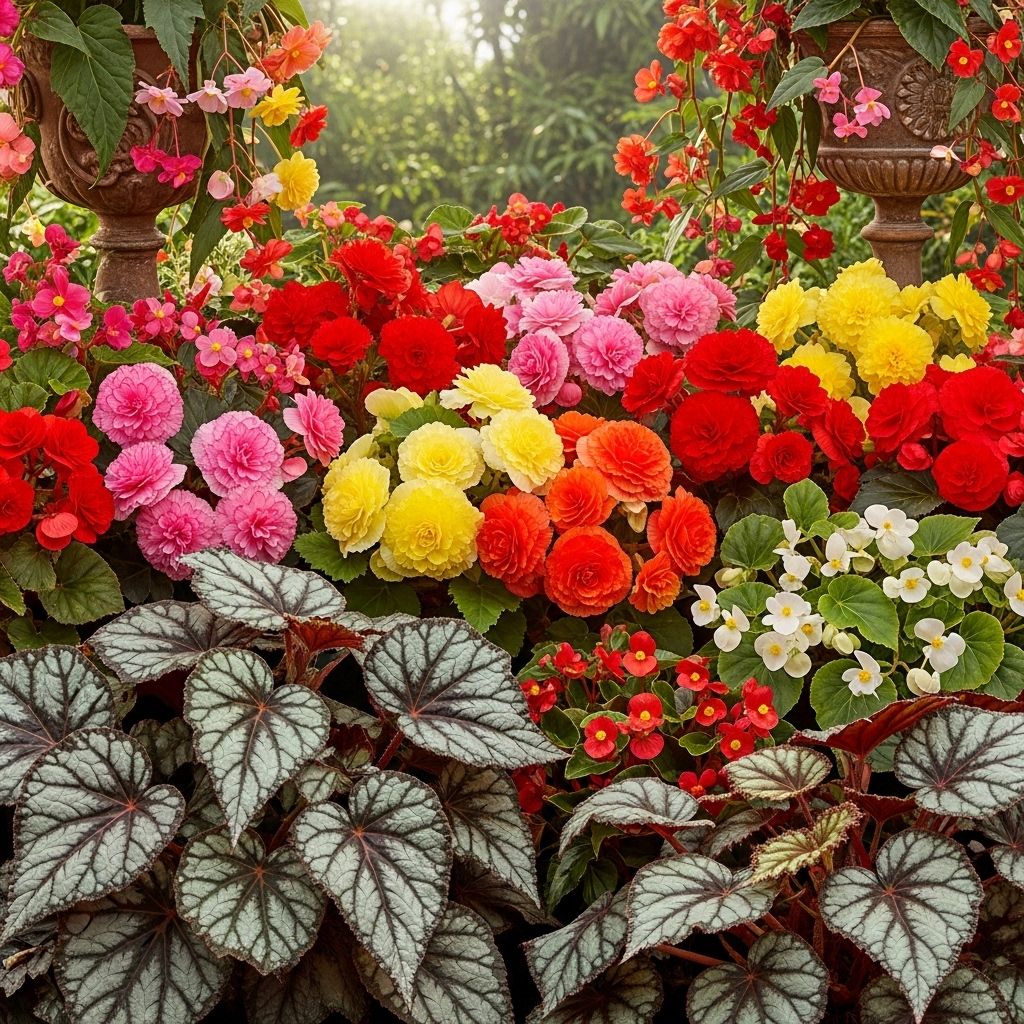Types Of Begonias: 49 Stunning Varieties For Your Garden
Explore 49 stunning begonia varieties to brighten your garden or home, from lush blooms to striking foliage, for every shade or sun setting.

Image: HearthJunction Design Team
Begonia Varieties: 49 Different Types of Begonia You’ll Love
Begonias are among the most beloved ornamental plants, admired for their vibrant flowers, unique foliage, and unparalleled versatility. Whether you’re seeking a splash of color for your indoor space, a lush groundcover under the canopy, or a show-stopping container centerpiece, there’s a begonia variety perfect for your needs. In this ultimate guide, we’ll explore 49 begonia varieties, including essential details, care insights, and planting inspirations for each.
Understanding Begonias
Begonias belong to the family Begoniaceae, comprising over 2,000 species and innumerable hybrids. They thrive in diverse conditions, ranging from deep shade to filtered sunlight, making them a go-to plant for both beginner and expert gardeners. Most begonias are tender perennials, often treated as annuals in regions with cold winters. Their delightful blooms, dramatic leaves, and adaptability explain their popularity in both indoor and outdoor gardening.
Begonia Types and Growth Habits
The begonia genus is vast, but most cultivated varieties fall into these main groups:
- Fibrous Begonias: Known for their fibrous root systems, upright or mounding growth, and a propensity for abundant flowering.
- Tuberous Begonias: Recognized for large, showy blooms arising from tubers. Often grown for seasonal displays.
- Rhizomatous Begonias: Famed for their unique foliage, these spread by thick rhizomes and are prized as houseplants.
- Rex Begonias: A subgroup of rhizomatous begonias, celebrated for their spectacular leaf patterns and colors.
- Cane Begonias: Also called “angel wing” begonias due to their leaf shape, these feature segmented, bamboo-like stems.
- Hardy Begonias: Resilient, withstanding cooler climates longer than most other types.
49 Breathtaking Begonia Varieties
Below, we explore top begonia varieties, grouped by their popular categories, each with standout features and inspiration on how to use them in your own plantings.
Rieger (Elatior) Begonias
- Elatior Valentino Pink
Height: 12″ tall, 12″ wide
This variety boasts peony-like double blooms in shades of pink with creamy yellow centers. Perfect for containers or shade gardens where a romantic, fluffy bloom is desired. - Amstel Batik
Height: 16″ tall, 12″ wide
Vivid coral orange rosettes make this a standout choice for shady pots or beds. Try underplanting a majesty palm for tropical drama, or combine with purple lobelia for vibrant contrast. - Amstel Veronica
Height: 16″ tall, 12″ wide
Clusters of pale reddish-orange flowers bloom upright, offering continuous color. Plant in small groups for maximum visual impact.
Tuberous Begonias
- Nonstop Begonia Series
Renowned for non-stop blooms from late spring to frost. Available in a rainbow of colors, they perform beautifully in hanging baskets, containers, and shaded garden beds. - Doubble Red, Yellow, and White
Lush, double blooms in single hues bring a cloud-like effect. The white double begonia bulbs are especially prized for their elegance and nonstop summer-to-frost flowering. Ideal for patios, shaded gardens, and window boxes. - Picotee Lace
Frilled petals edged in contrasting color for a unique, eye-catching look. - Champagne
Soft, golden blooms with a subtle blush, perfect for creating a gentle, romantic planting scheme.
Fibrous (Wax) Begonias
- Big Series
As the name suggests, these are larger than typical wax begonias, with bigger leaves and flowers. Available in bold reds, pinks, and whites, they make excellent bedding or edging plants. - Ambassador Series
Compact and early flowering, sporting dense clusters of red, white, or pink blooms. Excellent for mass plantings or groundcover beneath trees.
Rhizomatous and Rex Begonias
- Escargot
The unmistakable swirl pattern on each leaf makes this rex begonia a showpiece. Its spiral leaf design is reminiscent of a snail’s shell, with silvery green and deep bronze bicoloration. - Marmaduke
Large, deeply lobed foliage splashed in bright yellow and red. Its bold appearance makes it perfect for statement containers. - Fireworks
Deep purple leaves highlighted by metallic silver and jagged, starburst-like patterns. - Beef Steak (B. erythrophylla)
Glossy, round, dark green leaves with burgundy undersides. When struck by sunlight, the color play is sensational – a favorite for foliage lovers. - Mimi
Small, compact rex with pink-blushed leaves and a silvery sheen. Sweet and elegant.
Cane (Angel Wing) Begonias
- Lucerna
Classic angel wing variety with olive-green, silver-spotted leaves and clusters of bright pink flowers. Tall and upright—great for backgrounds or as an indoor specimen. - Sophie Cecile
Green leaves with prominent white spots and large, drooping trusses of pink flowers. Ideal for bright, indirect light indoors or sheltered outdoor spots. - Superba
Large, pronounced wing-shaped leaves with deep green coloring and profuse red blooms. Striking in big containers or indoor corners.
Hardy Begonias
- Begonia grandis
Native to China and one of the few begonias to tolerate cooler (even freezing) climates. Heart-shaped leaves, pink or white blooms late in the season. Adds interest in woodland gardens.
Other Notable Varieties
- Dragon Wing Begonia
Glossy leaves and pendulous clusters of bright red or pink blooms. Excellent for hanging baskets and containers due to trailing growth. - Richmond Begonia
Rose-pink blooms with bronze-green foliage, tolerant of more sun than other types. - Gryphon
Dramatic, large leaves with silver, green, and burgundy marbling. Provides a lush, tropical look indoors or out. - Boliviensis
Narrow, winged foliage and masses of bright, tubular blossoms in red, orange, or white—magnificent in hanging baskets. - Benariensis
Robust and weather-resistant, offering continuous bloom with minimal care.
Planting and Growing Begonias: Quick Tips
- Light: Most begonias thrive in filtered shade or dappled light. Some, like Richmond and certain cane types, tolerate more sun if kept moist.
- Soil: Use light, humus-rich, and well-draining soil. Container plantings benefit from high-quality potting mix.
- Water: Water regularly, but never let plants sit in soggy soil. Allow the top inch to dry before watering again.
- Humidity: Most begonias appreciate higher humidity, especially indoors. Mist regularly or use pebble trays if the air is dry.
- Fertilizer: Feed with a balanced, diluted fertilizer every 2-4 weeks during the growing season for best results.
- Pests and Problems: Watch out for spider mites, aphids, and mealybugs. Overwatering can lead to root or stem rot and powdery mildew.
Design Tips: Arranging Begonias
- Containers: Mix upright varieties like Elatior begonias with trailing ones (Boliviensis or Dragon Wing) for cascading color.
- Garden Beds: Plant in drifts or groupings for bold swathes of color. Combine with hostas, caladiums, ferns, or coleus for a lush, shade-loving display.
- Indoor Displays: Rhizomatous and rex begonias are ideal as tabletop or shelf plants, providing year-round leaf interest.
Frequently Asked Questions (FAQs)
Q: What is the best begonia for deep shade?
A: Rhizomatous and rex begonias thrive in lower light conditions and offer striking leaf color and texture.
Q: Can begonias survive winter outdoors?
A: Most begonias are tender perennials and cannot survive frost. Tuberous varieties can be dug up and overwintered indoors. Only a few, like Begonia grandis, are considered hardy in temperate regions.
Q: How do I propagate begonias?
A: Begonias can be propagated via leaf or stem cuttings. Place the cuttings in moist, well-draining soil and keep in a humid environment until rooted.
Q: Do begonias attract pollinators?
A: Yes, their vibrant blooms can attract pollinators, especially in shaded gardens where few other flowers bloom profusely.
Q: Are begonias toxic to pets?
A: Yes, begonias contain compounds (calcium oxalates) that can cause irritation if ingested by pets. Always keep them out of reach of curious animals.
Begonias at a Glance: Quick Comparison Table
| Variety | Type | Height | Best Use | Notable Feature |
|---|---|---|---|---|
| Elatior Valentino Pink | Rieger (Elatior) | 12″ | Containers, Shade Gardens | Peony-like, double blooms |
| Amstel Batik | Rieger | 16″ | Pots, Underplanting Palms | Coral orange flowers |
| Escargot | Rex | Varied | Indoor, Foliage Displays | Spiral, patterned leaves |
| Big Series | Fibrous | Varied | Bedding, Edging | Large blooms & leaves |
| Begonia grandis | Hardy | Varied | Woodland Gardens | Cold tolerance |
| Dragon Wing | Fibrous | 18-24″ | Hanging Baskets | Arching growth, big blooms |
Final Thoughts
With so many begonia varieties to choose from, there’s truly a plant for every taste, space, and lighting situation. Whether you’re a seasoned collector or a curious beginner, exploring the world of begonias rewards you with enduring color and texture through the growing season. Mix and match types for a layered display, experiment with dramatic foliage indoors, or simply enjoy the nonstop blooms on your porch — begonias bring easy beauty wherever they grow.
References
Read full bio of Anjali Sayee












